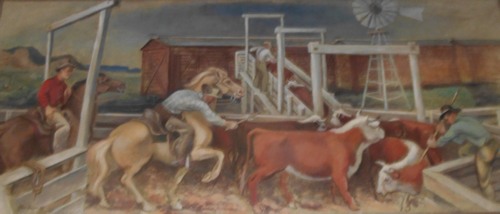Books by
Michael Barr
Order Here: |
|
The
1930s were tough times in Texas. The stock market crash of 1929 and
the Great Depression sent Texans searching for expressions of beauty
and optimism wherever they could find them. In Fredericksburg
and other Texas towns, they need only stroll down to the local post
office.
In 1934 the state and the country were in crisis. One of every five
American workers was unemployed.
To relieve suffering, Franklin Roosevelt and the New Dealers in Washington
created programs to put people back to work.
Artists too were out of work in huge numbers, but Washington bureaucrats
were reluctant to include artists in federal work relief programs
that were just beginning to put a few dollars in the pockets of unemployed
workers.
Then in 1934 New Dealers put reservations aside and formed the Public
Works of Art Project. The program paid artists to paint pictures and
murals for new public buildings. To pay for the program the government
set aside 1 percent of new construction costs.
The men and women who dreamed up the program drew inspiration from
Diego Rivera and other 20th century Mexican muralists.
The government recruited artists through advertisements placed in
newspapers around the country. An artist with an interest in a particular
project submitted detailed sketches to the PWAP in Washington.
Selected artists received $38.38 a week to create murals for new post
offices and other federal buildings. Artists had to supply their own
paints and materials.
A few of the muralists, like Thomas Hart Benton, were already major
artists. Other participants, like Jackson Pollock, Peter Hurd and
Tom Lea, were just youngsters and relatively unknown.
Cities and towns all over the country expressed interest in the project.
For some isolated communities it was their first direct encounter
with the fine arts.
In Texas the federal government commissioned about 97 murals. According
to the Handbook of Texas between 80 and 90 still exist. The rest have
been destroyed or have disappeared over time.
New Deal officials insisted each mural had to reflect the character
of the region it represented. That meant the mural had to please not
only Washington bureaucrats but local officials as well.
Many Texas post office murals highlighted local industries. Other
murals expressed themes in Texas history, legends and heroes, including
Texas Rangers, pioneers and cowboys.
New Dealers discouraged any kind of social realism. These murals did
not show jobless Americans standing in soup lines or displaced dust
bowl farmers on the road to California. These works of art were intended
to inspire belief in the future and hope for better times.
The program had its controversies. Some murals were racially insensitive.
Some people deplored what they considered excessive government patronage.
But by most indicators, Americans appreciated the effort. |
 |
Fredericksburg
Post Office Mural
Photo courtesy Michael
Barr, January 2019 |
When Fredericksburg
completed its new post office building in 1941, Postmaster R. W. Klingelhoefer
applied for a post office mural. Later that year the government approved
the application.
Otis Dozier, a veteran artist and muralist from Forney,
Texas, received the Fredericksburg
commission. He completed the 5 ft. by 12 ft. oil on canvas painting,
showing cowboys loading cattle into a railroad car, in May 1942.
The artist was on hand when postal officials hung the painting in
the lobby of the new post office on the corner of Main and Crockett
Streets. The painting now hangs above the door in the newest post
office on Highway 87 North.
Other Hill Country
towns have murals. Artist Ethel Edwards painted a scene entitled
"Afternoon on a Texas Ranch" for the Lampasas Post Office in 1938.
City officials later moved the painting to City Hall. Artist Gordon
Grant painted "Texas Immigrant" for the Brady Post Office in 1939.
The art was conservative, even for its time. Much of it would be dismissed
by art critics today. But to focus solely on artistic quality is missing
the point.
Post office murals are cultural artifacts. They are the people's art.
The program that produced them launched an historic and unprecedented
effort by the federal government to use art to spread beauty and inspire
hope in our country's most difficult time. |
© Michael
Barr
"Hindsights" February
15 , 2019 Column
Sources:
"Texas Historical Commission to document local painting," Brownfield
News, January 22, 1995.
"Committee Named To Plan Post Office Dedication," Fredericksburg
Standard, July 24, 1941.
Jerry Adler, "The Art of the New Deal," Smithsonian Magazine,
June 2009.
"New Mural that Adorns Post Office Lobby," Fredericksburg Standard,
May 28, 1942. |
|
|
